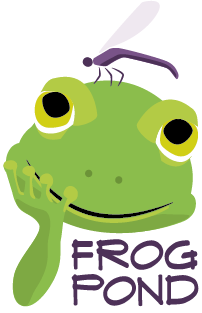Curriculum
The Frog Pond curriculum is enriched with multi-sensory experiences that tend to be messy and “hands-on.” We especially enjoy the teachings of Bev Bos for curriculum models. You will notice that our children are encouraged to play with dirt, sand, and other solids, water, and other liquids; air and wind; light and heat (through cooking, etc.), and experience the sight, smell, and warmth of our outdoor fires.
The resources and teachings by Dr. Becky Bailey are our primary resource for behavior management policies.
Science
At Frog Pond Early Learning Center, we are committed to teaching children to love the earth and its creatures, to understand their connection to the web of life, and their responsibility for helping to take care of the earth. We believe that children learn best by experiencing and exploring, following their interests. We want to encourage and direct their natural curiosity. We also incorporate opportunities to practice emergent science and math skills as well as language development and physical and social skills in the lessons.
How does this translate into “lessons” for 2 and 3
and 4 year-olds?
First, we look at bugs, snakes, worms, and toads with the same wonder, eagerness, and care with which we would examine a beautiful flower or butterfly. We teach that all creatures deserve respect and should be handled gently. When we are with the children, we help them notice the details around them, patterns, and cycles of change. We ask questions and solicit questions from them. We may or may not answer the questions. The process of asking is important, and sometimes it is better for them to find their own answers.
Simply Noticing
It is usually enough for the youngest children to notice, talk about what we see, and reinforce the new language with songs and fingerplays. With older children, we may extend our observations by measuring (using units they can relate to like hand span, body height, or comparison to familiar objects), sorting and classifying, or looking at things from different viewpoints. (“What would that look like from on top of the slide or upside down?”)
Experimentation
Sometimes we make predictions and test our ideas with experimentation. When a child asked, “What makes garbage stink?” we saved food scraps and grass clippings to watch what happened over a two week period. We discovered that wet garbage spoils faster than dry and that food scraps are smellier than grass clippings. After a few days, mold and mildew grew.
Hands-On
Hands-on activities and experiments let the children explore with all their senses, with concrete experiences, repetition, and a touch of magic. Simple paint mixing is a classic experiment. Mixing red and yellow always makes orange, no matter how often we try it. If we add blue, something different happens. What if we look through red, yellow, and blue cellophane? From there, it is just a step to chasing rainbows in the sprinkler on a sunny day.
Pulling apart a dead log, feeling the wood crumble into soil. Smelling the damp, earthy smell and discovering the amazing menagerie of “decomposers” that live there (centipedes, slugs, grubs, ants, spiders, shiny black beetles, and once, a shrew!) makes the abstract concept of “life in a dead tree” real.
Imagination
I like to use imagination and pretend play to teach some concepts. With music and tulle scarves, we can pretend to be water droplets and experience the water cycle—water flow, evaporation, clouds gathering, and rainfall. The rainstorm is very exciting! Walking in the rain and puddle jumping are concrete experiences that help the children to understand the pretend game. With 3-5 year-olds, we have “made clouds” by applying ice to a jar of hot water and watching the water vapor condense on the sides. We may touch the hot water and the ice block with a younger group to experience hot and cold.
Our Pets
Our pets are important science teachers. The goats, chickens, lizards, and hermit crabs feel, smell, sound, and act differently from people. Still, they need food, water, shelter, and space like all animals. They even poop, just like us. Children learn to be gentle rather than rough with the animals, or brave and assertive rather than fearful, depending on their personalities. We have learned some hard lessons about predators and prey, life and death from our pet tragedies.






